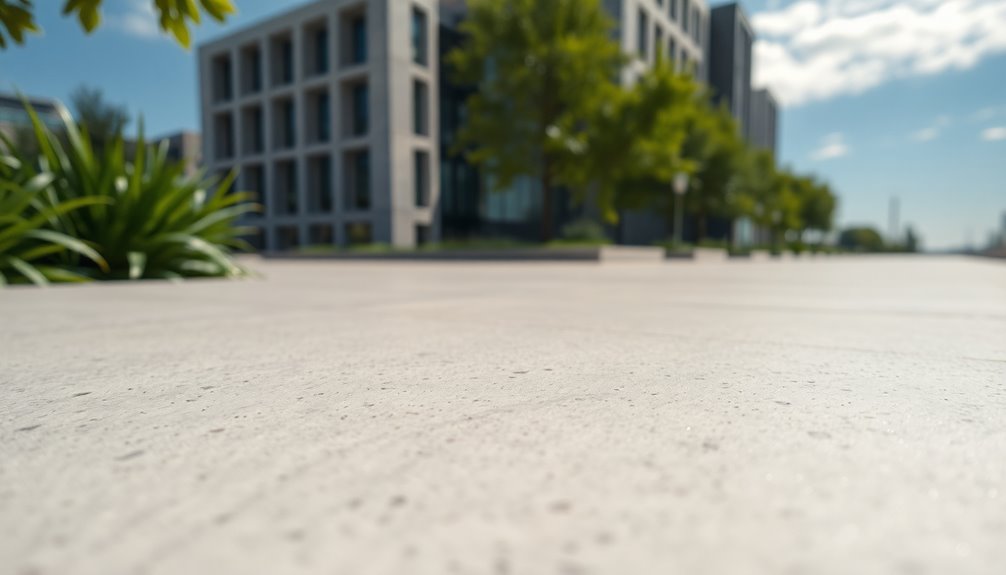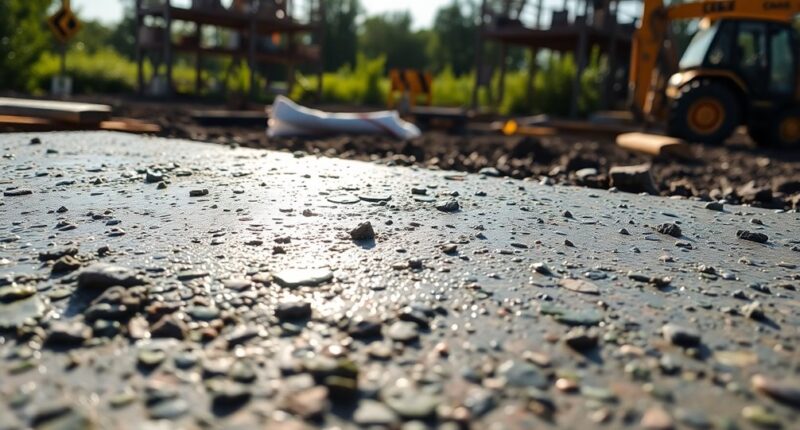Carbon-negative materials are changing the game for concrete and cement production. They cut CO₂ emissions during manufacturing and absorb carbon over their lifespan. By using innovative methods like seawater and electricity, these materials create essential minerals, even utilizing waste products for sustainability. By adopting carbon-negative concrete, you can contribute to a greener future, while also benefiting from stronger and more efficient building materials. Discover how this technology can revolutionize your construction projects.
Key Takeaways
- Carbon-negative concrete absorbs more CO₂ than produced, significantly reducing its carbon footprint in construction.
- Innovative production methods utilize seawater and CO₂ to create sustainable cement minerals, enhancing environmental benefits.
- The use of biochar in concrete increases compressive strength by 10-30%, improving performance and durability.
- Carbon-negative options can reduce cement-related emissions by up to 70%, addressing a significant portion of global CO₂ emissions.
- Regulatory changes and ongoing research are essential for widespread adoption of carbon-negative concrete in the construction industry.

As the world grapples with climate change, carbon-negative concrete emerges as a promising solution that not only cuts CO₂ emissions during production but also actively absorbs carbon from the atmosphere over its lifespan. This innovative material addresses a significant issue, as cement production alone accounts for about 9% of global CO₂ emissions. By integrating carbon capture, utilization, and storage (CCUS) technologies, carbon-negative concrete not only mitigates emissions but also contributes positively to the environment.
Researchers at Northwestern University have pioneered methods to produce carbon-negative materials using seawater, electricity, and CO₂, creating essential minerals like calcium carbonate and magnesium hydroxide for cement. One effective variant, biochar-enhanced concrete, not only boosts compressive strength by 10-30% with just a 10% substitution of cement but also stores carbon for thousands of years. This innovative approach can utilize waste materials such as brine and steel slag, helping reduce environmental waste while providing a sustainable alternative. Additionally, concrete made with Biographite® carbon can be recycled at the end of its life, ensuring long-term carbon storage.
The environmental impact of carbon-negative concrete is profound. It offsets more CO₂ than it emits throughout its lifespan, making it a powerful ally in the fight against climate change. While traditional cement production contributes around 8% to global emissions, carbon-negative options can reduce emissions by up to 70% by replacing high-carbon clinker with more sustainable materials.
Plus, the process can yield hydrogen as a clean fuel byproduct, further enhancing its eco-friendliness.
Despite its potential, the path to widespread adoption isn't without challenges. Existing building codes and regulations can slow down the implementation of carbon-negative concrete. However, initiatives like the Federal Buy Clean Initiative in the U.S. encourage the use of lower-carbon construction materials.
With ongoing research and pilot projects showcasing scalability, carbon-negative concrete stands on the brink of revolutionizing the construction industry, offering a greener alternative that promises a more sustainable future.
Frequently Asked Questions
How Does Carbon-Negative Material Affect Concrete Strength?
When you use carbon-negative materials in concrete, you'll find that they can maintain comparable strength to traditional cement, often reaching around 4,000 pounds per square inch.
By treating materials like biochar with concrete wastewater, you enhance their performance in mixtures.
Additionally, using seawater-based materials can lead to engineered mineral precipitation that boosts strength and durability.
This means you can achieve robust concrete while also contributing to a more sustainable construction industry.
What Are the Cost Implications of Using Carbon-Negative Materials?
Using carbon-negative materials feels like planting a tree; it costs more upfront but promises a greener future.
You'll find that while the initial investment is higher due to advanced production processes, the long-term savings and environmental benefits are worth it.
As technology evolves, costs may decrease, making these materials more accessible.
Are There Any Environmental Regulations for Carbon-Negative Concrete?
Yes, there are environmental regulations for carbon-negative concrete.
You'll find that some regions, like Marin County, California, have implemented low-carbon concrete codes. These codes mandate specific mix designs and allow for alternatives to traditional cement, significantly lowering emissions.
As awareness grows, more jurisdictions are likely to adopt similar regulations. Staying informed about these standards can help you contribute to sustainable construction practices while reducing the environmental impact of your projects.
How Does Carbon-Negative Concrete Compare to Traditional Options in Durability?
When comparing carbon-negative concrete to traditional options, you'll find that carbon-negative types often outperform in durability.
They can resist wear and tear better, thanks to materials like biochar that enhance their strength. You might notice improved freeze/thaw resistance and lower water absorption rates, making them suitable for various environments.
Ultimately, if you're focused on longevity and sustainability, carbon-negative concrete could be the superior choice for your construction needs.
Can Carbon-Negative Materials Be Used in Existing Concrete Structures?
Yes, you can use carbon-negative materials in existing concrete structures!
By recycling cement waste and incorporating low-carbon alternatives, you enhance sustainability. Techniques like accelerated mineralization allow for effective CO2 storage within your current frameworks.
However, you may face challenges, such as the need for updated building codes and regulations.
Embracing these materials not only benefits the environment but can also improve the durability and performance of your structures.
Conclusion
So, it turns out that a carbon-negative material could be the superhero concrete never knew it needed. While we've spent decades pouring tons of carbon emissions into the atmosphere, this innovative solution swoops in to save the day—who knew our buildings could have a better carbon footprint than we do? As we strive for greener construction, let's hope this material doesn't just become a fleeting trend, but rather the foundation of a truly sustainable future.









